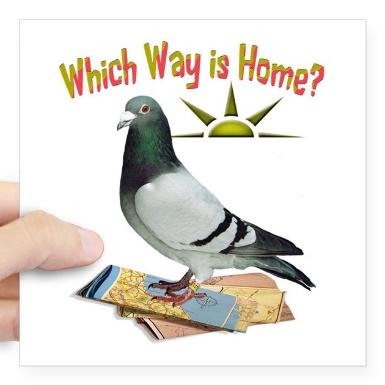If you find yourself visited / befriended by a racing / show pigeon – 
First things first the bird could well have one or more of the following on its legs which differentiates them from feral pigeons.
Life Ring the Birds unique identification ring
Race Rubber
Name address / Telephone ring
Electronic Timing Ring (please note some of these can carry the owners telephone number).
How to Care for a Stray Pigeon
Water:
Most stray birds are tired, hungry and thirsty. Water is necessary before all else. Pigeons drink by suction, so please provide water from a container that is open topped and should be at least 2.5 – 3 cm’s deep i.e., a dish, an old margarine container, small cup, etc., is best. While a thirsty bird may drink immediately, it also may not. If a bird has gone without water for a while it is sometimes a bit less than itself. It may be so tired, it doesn’t even realise that water is in front of it, especially if the water container is different from what it is familiar with. A trick often used is to trickle a few drops of water from above into the container to make a splashing sound. When they hear that, most birds will invariably head to drink.
Food:
Pigeons are grain eaters. While feral / street pigeons will eat bread, most domesticated birds have been raised on a multi-grain diet. You could try feeding them something from around the house. Rice, Popcorn (maize), split peas, barley, wheat, canary seed, etc. are all good first options to feed a lost bird with. It’s important that the grains should be provided raw and not cooked. Water needs to be available has pigeons normally drink immediately after eating.
After a drink and a little feed the racing pigeon may restart its journey home again however if after a couple of days if its still around or shows an inability to take flight it may be time to offer it more assistance.
In what / where should you keep It In?
Any container that a dog or cat can’t get into in a place / position that a dog or cat would find difficult to access would be fine. An old bird cage would do, as well as a cardboard box – a screen on top of such a box is better than simply closing the flaps since there needs to be enough light for the bird to see any food and water.
Finding the bird’s owner
The bird has what is known as a life ring which helps identify the bird’s owner this life ring carries a unique set of numbers that firstly tells you the organisation that the bird is registered under the year the bird was born and the unique number that helps the issuing organisation trace the bird’s owner. There could also be a telephone / name & address ring that carries the owners contact telephone number. You may also see a telephone number and address on the pigeon’s wing when spread please look both sides of the wing as some owners stamp their details on the top side others the underside of the wing. From the unique life ring on its leg, the owner can sometimes be traced through one of the national pigeon organizations.
List of UK & EU unions
Ring Prefix UK Organisation / Union Website Contact Information Telephone Contact Information
SU Scottish Homing Union Report Lost SU Rung Pigeons
01698 768 939
GB Royal Racing Pigeon Association Report Lost GB Rung Pigeons 01452 713 529
IHU Irish Homing Union Report Lost IHU Rung Pigeons
WHU Welsh Homing Pigeon Union Report Lost WHU Rung Pigeons
01443 441 010
NEHU North of England Homing Union Report Lost NEHU Rung Pigeons
01912 625 388
NWHU North West Homing Union Report Lost NWHU Rung Pigeons 07933 068638 or here using website form
NPA National Pigeon Association nationalpigeonassociation.co.uk 01458851617
BE or Belg Belgium www.kbdb.be
NL Netherlands www.npoveenendaal.nl
FR French www.colombophiliefr.com
DV German www.brieftaube.de
Please note information believed to be correct at time of update.
